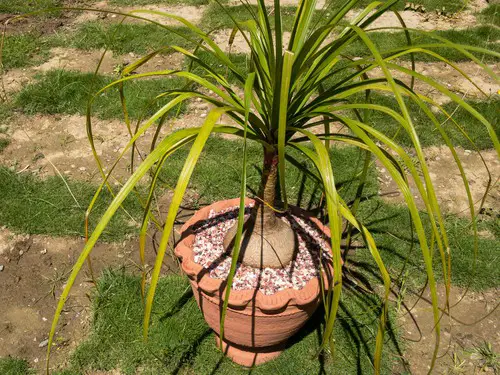The Ponytail Palm is a captivating wonder in our homes and gardens with its distinctive swollen trunk and cascading foliage. Bringing a touch of tropical charm to any space, this plant’s thick and bulbous trunk, reminiscent of a ponytail, has a unique appearance that distinguishes it from other houseplants.
Nonetheless, it can be disheartening to see your precious Ponytail Palm ailing. The softening of this plant’s iconic trunk is a significant concern, indicating an underlying problem that demands your attention. Join us as we uncover the potential causes of ponytail palm trunk softness ranging from improper care practices to pests and diseases.
Root rot being the leading cause of this problem, we will also provide practical solutions such as adjusting watering routines and optimizing soil conditions to nurse your Ponytail Palm back to health and witness the reinvigoration of its majestic trunk.
Key Takeaways
- A soft trunk in a ponytail palm can be a sign of overwatering, poor drainage, or root rot.
- Root rot is the most common cause of a soft trunk in ponytail palms.
- Proper care and maintenance include adjusting watering routines, optimizing soil conditions, and implementing targeted pest management strategies.
Ponytail Palm Trunk Soft
Ponytail palms are known for their unique bulbous trunk and long, thin leaves that resemble a ponytail. However, sometimes the trunk of a ponytail palm can become soft, which could indicate an underlying problem. This section will explore the causes of a soft trunk and how to treat it.
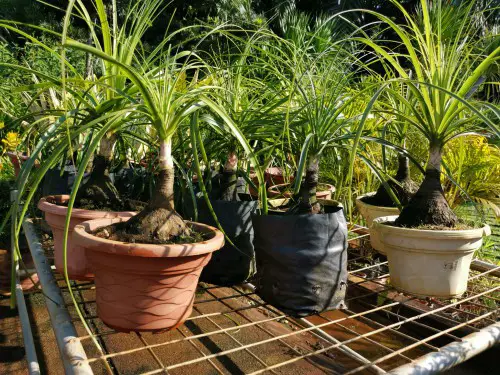
Causes of Soft Trunk
There are several reasons why the trunk of a ponytail palm may become soft. Some of the common causes include:
- Overwatering: Ponytail palms do not require frequent watering and can thrive in dry conditions. Overwatering can cause the roots to rot, leading to a soft trunk.
- Poor Drainage: If the pot or soil does not have proper drainage, it can cause water to accumulate around the roots, leading to root rot and a soft trunk.
- Fungal Infection: A rare fungal infection can also cause the trunk to become soft.
- Dehydration: While overwatering can cause a soft trunk, dehydration can also be problematic. The trunk can become soft and damaged if the soil becomes too dry.
Treatment for Soft Trunk
Take immediate action if you notice your ponytail palm trunk softening. Here are some steps you can take:
- Repotting: Repot the plant into a pot with better drainage and aeration.
- Cut away damaged parts: If there is stem or crown rot, it is essential to cut away the damaged parts of the plant to prevent the infection from spreading.
- Revive the plant: It’s possible to revive a dry plant by adopting a good watering schedule and allowing the soil to dry out between waterings. You can also apply a callus-inducing hormone to the damaged area to encourage new growth.
Root Rot
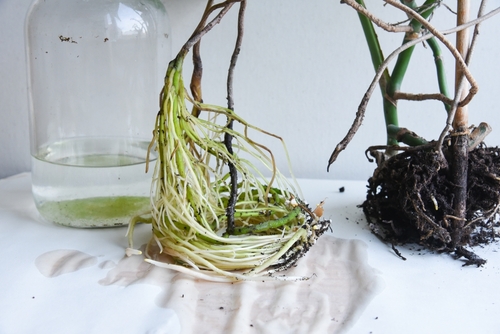
As outlined earlier, root rot is the leading cause of softening of the Ponytail palm trunk. The main cause is a fungus thriving in moist environments leading to waterlogged roots and rotting. The good news is that you can watch out for the following symptoms for addressing and treating root rot.
Symptoms of Root Rot
The symptoms of root rot can vary depending on the issue’s severity. For example, in the early stages, you may notice the leaves of your ponytail palm turning yellow or brown. The plant wilting even though the soil is moist could also indicate root rot.
As the decay progresses, the roots may become discolored and mushy, causing the plant’s trunk to become soft and spongy to the touch.
Preventing Root Rot
Preventing root rot is the best way to keep your ponytail palm healthy. The most effective strategy is adopting a suitable watering schedule. Note that Ponytail palms are drought-tolerant and do not need frequent watering.
The accepted rule is to ensure the top two inches of the soil are completely dry before feeding it with water. Also, ensure the pot has proper drainage to prevent waterlogging.
Treating Root Rot
If you suspect that your ponytail palm has root rot, there are steps you can take to treat it. First, remove the plant from the pot and examine the roots. If they are mushy or discolored, carefully trim away the affected areas with a clean, sharp pair of scissors or pruning shears.
Then, repot the plant in fresh, well-draining soil and make sure not to overwater it. If the root rot is severe, treating the plant with a fungicide may be necessary.
Soil and Watering
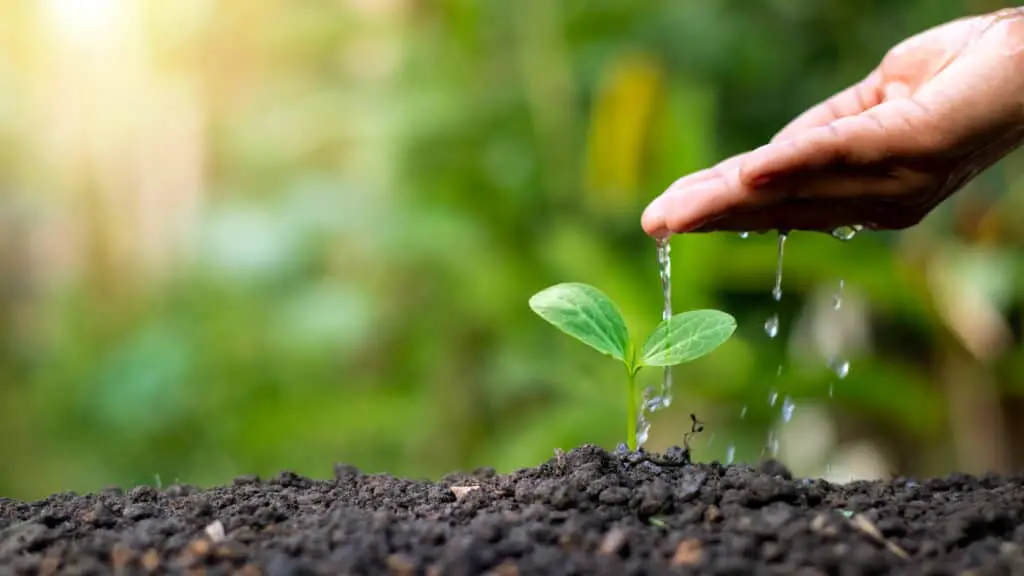
Proper Soil Mixture
The soil mixture is an essential factor in the health of a ponytail palm. It needs a well-draining soil mixture that can prevent waterlogging. A good potting mix for ponytail palm should contain perlite, gravel, and peat.
Perlite helps to improve drainage, while gravel provides good aeration. In addition, peat retains moisture and improves the soil’s water-holding capacity. You can also add pumice to enhance the soil mixture drainage.
Watering Schedule
Ponytail palms are drought-tolerant plants that can survive long periods without water. Overwatering is a common cause of a soft trunk on a ponytail palm. Establishing a watering schedule that allows the soil to dry out between watering times is essential.
Moreover, watering frequency depends on the temperature, humidity, and light conditions. All in all, experienced gardeners and plant care enthusiasts recommend watering once in two weeks.
Watering Techniques
First and foremost, saturate the soil thoroughly when watering your Ponytail palm plant. Ensure to slowly pour the water to allow the soil to absorb it. Then drain excess water from the pot to prevent waterlogging.
Also, before feeding the plant with water, first store it in a container for a few days before using it to water the plant. This allows the chlorine and other chemicals in tap water to evaporate.
Light and Temperature
Light Requirements

Ponytail palm thrives in bright, indirect light. It can tolerate some direct sunlight, but too much can scorch its leaves. If the plant is not getting enough light, it may grow slowly, become leggy, and its leaves may turn yellow.
On the other hand, excessive exposure to sunlight causes the leaves to turn brown and wilt. Also, low light conditions lead to weakening and susceptibility to pests and diseases. Therefore, finding the right balance of light for the plant to thrive is essential.
Temperature Requirements
Ponytail palm can tolerate a wide range of temperatures, but it prefers warm temperatures between 65°F to 85°F (18°C to 29°C). Nonetheless, te plant can tolerate temperatures as low as 50°F (10°C) and as high as 100°F (38°C).
During hot summer, keeping the plant away from direct sunlight and protecting it from extreme heat is essential. The plant may become dormant in low-temperature conditions and stop growing until the temperature rises.
The Ponytail palm’s native habitat is the desert climate making it adaptable to harsh dry conditions. It can tolerate low humidity levels and infrequent watering. However, ensure you don’t expose your plant to cold drafts or sudden temperature changes, which can cause stress and damage to the plant.
Pests and Diseases
Common Pests
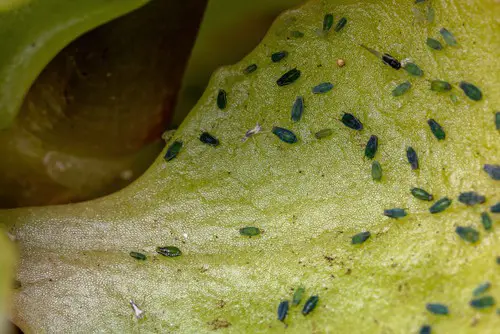
Ponytail palms are generally hardy plants that are resistant to pests. However, they are susceptible to pests such as mealybugs, scale, and spider mites without proper care. You can identify infestation by small, white, cotton-like masses on the plant’s leaves, stems, and trunk. If left untreated, they can cause damage to the plant and even kill it.
To remove mealybugs and other pests, use a cotton swab dipped in rubbing alcohol to wipe them off the plant. You can also use insecticidal soap or neem oil to control the infestation. Be sure to follow the instructions on the label carefully, as overuse of these products can damage the plant.
Common Diseases
Ponytail palms can also be affected by fungal infections, mold, and crown rot. Yellow or brown spots on the leaves indicate fungal infections. To identify mold on your Ponytail palm, check for a white, powdery substance on leaves and stems. Additionally, the softening of the plant’s
To treat fungal infections and mold, remove the affected leaves and stems and apply a fungicide to the plant. Be sure to follow the instructions on the label carefully. Crown rot is a more severe condition and can be challenging to treat.
If you suspect your plant has crown rot, remove it from its pot and inspect the roots. Black and mushy roots require immediate trim. Next, repot the plant in fresh soil and ensure the new container has good drainage to prevent future issues.
Care and Maintenance
Care Routine
Ponytail palms are easy to care for and require minimal maintenance. They are drought-tolerant and prefer well-draining soil. Ensure the top two inches of soil is dry before watering again. Overwatering can lead to root rot and a soft trunk. The accepted rule is to water once every 1-2 weeks.
Ponytail palms prefer bright, indirect light and can tolerate some direct sunlight. They can also thrive in low light conditions, but growth may be slower. It is essential to rotate the plant occasionally to ensure even growth.
Fertilizing
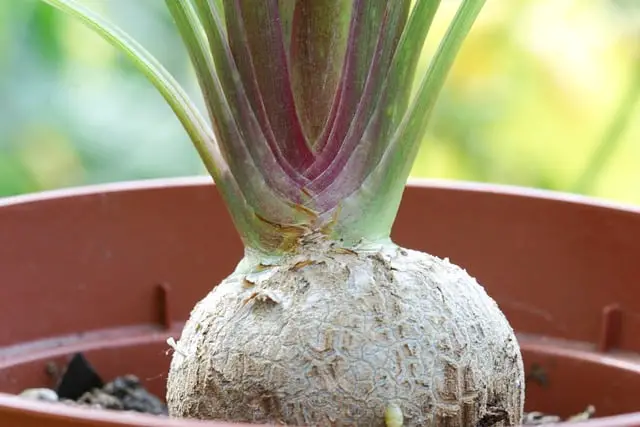
Ponytail palms do not require frequent fertilization. Still, feeding this plant with slow-releasing fertilizer can help promote growth and maintain the plant’s health. Fertilize once every six months during the growing season (spring and summer) for the best results.
Repotting
Ponytail palms prefer to be slightly root-bound and do not require frequent repotting. Only repot your house plant when it outgrows its current pot or after the soil compacts. The general rule is repotting to a larger container every 2-3 years using well-draining soil.
Common Problems
Ponytail palms are relatively easy to care for but can still experience a few common problems. Here are some of the most common issues you might encounter with your ponytail palm:
Yellowing Leaves
If your ponytail palm’s leaves turn yellow, it could indicate overwatering, underwatering, or nutrient deficiencies. To fix the issue, ensure you water your plant correctly and provide enough nutrients.
Brown Spots
Brown spots on the leaves of your ponytail palm could be a sign of insect infestations, fungal infections, or sunburn. Ensure your plant is not getting too much direct sunlight, and check for any signs of pests or disease.
Excessive Height
Ponytail palms can grow quite tall, but if your plant proliferates or becomes excessively tall, it could indicate a nitrogen deficiency. Ensure you provide your plant with enough nitrogen-rich fertilizer to promote healthy growth.
You also shouldn’t miss these other top picks in this category:
- Why Is My Oxalis Drooping?
- Orange Star Plant Drooping:
- Cactus Growing Arms: How to Promote Healthy Growth and Prevent Damage
Conclusion
Even with the most resilient and cherished species like the Ponytail Palm, problems are bound to arise if you don’t heed the proper care routine for household plants.
Our guide into the causes and solutions for a soft ponytail palm trunk has shed light on the potential culprits behind this concern and effective action to restore new life to your beloved Ponytail Palm.
Nonetheless, prevention is the best practice for maintaining healthy plants. Therefore, from early on, implement proper watering practices, ensure well-draining soil, and keep a vigilant eye for signs of pests or diseases to safeguard your Ponytail palm from future trunk softening.
Frequently Asked Questions
How do I identify root rot in a ponytail palm?
The soft, brown, and mushy roots can identify root rot in a ponytail palm. The plant leaves may turn yellow or brown, and the trunk may become soft and mushy. If the root rot is severe, the plant may wilt and die.
What are common problems with ponytail palms?
Common problems with ponytail palms include overwatering, underwatering, poor soil drainage, and lack of sunlight. Overwatering can lead to root rot and a soft trunk, while underwatering can cause the leaves to turn brown and dry. Poor soil drainage can also cause root rot, and a lack of sunlight can lead to stunted growth.
Why is the base of my ponytail palm soft?
The base of a ponytail palm may become soft due to overwatering or root rot. If the soil is too wet, the plant roots may start to rot, causing the trunk to become soft. Allowing the soil to dry out between watering is vital to prevent root rot.
What should the trunk of a healthy ponytail palm look like?
The trunk of a healthy ponytail palm should be firm and sturdy. It should not be soft or mushy to the touch. The plant leaves should also be green and vibrant, and the roots should be white and firm.

Hey, I’m Lisa and I’ve been an avid gardener for over 30 years. I love writing, talking and living in the garden! Feel free to connect with me on my socials below

